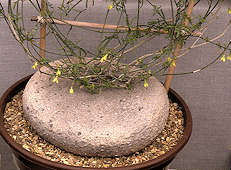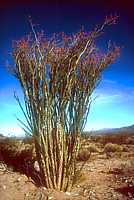The flowering plants (Magnoliophyta, angiosperms) can be divided into two groups, Dicotyledons and
Monocotyledons.
Dicotyledons (John Ray, 1703) are named for the two seed leaves or cotyledons produced from a sprouting seed with about 200,000 species within the group. Molecular analysis suggests that the Dicotyledons do not form a coherent taxonomic group derived from a single ancestor and in future may be divided into Eudicots whose pollen has three grooves and Palaeodicots whose pollen has a single groove.
  Common features among Dicotyledons are vascular bundles forming a ring within the stem, flowers with parts in multiples of four or five, leaves with a branched network of veins, roots develping from the radicle and pollen grains with three grooves.
Succulent Dicotyledons are found in many plant families, including the
Bean,
Cactus,
Ragwort,
Gesneriad,
Gourd,
Heather, Balsam, Ocotillo,
Mesemb,
Periwinkle,
Purslane,
Spurge,
Stonecrop and
Yam
families.
Within the Gymnosperms, the monotypic genus Welwitschia is an example of an archaic Dicotyledon that only ever produces two cotyledons that elongate with age.
Cacti are true Dicotyledons. These Hylocereus seedlings produce a pair of seed leaves.
    
|

 Families of Succulent Plants
Families of Succulent Plants 









